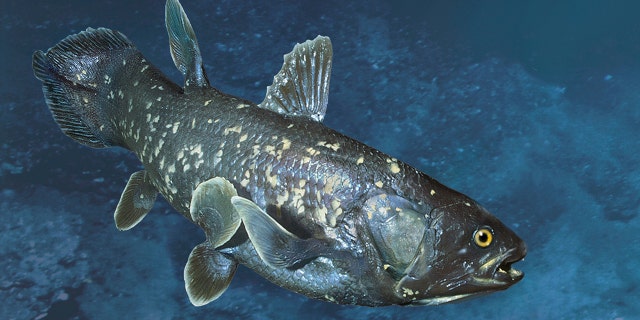Huge 420-million-year-old fish species rediscovered in Indian Ocean

A humongous “fossil fish” with origins that can be traced back 420 million years has resurfaced in the West Indian Ocean off the coast of Madagascar.
The 6.5-feet, up to 198-pound coelacanth (Latimeria chalumnae) was believed to have gone extinct at least a century ago. However, a recent study published in the SA Journal of Science revealed that as of May 2020 as many as 334 coelacanth captures had been documented.
12-YEAR-OLD FISERMAN WINS $15K FOR CATCHING 26-POUND FISH IN NEW YORK
The coelacanth species, also known as the “four-legged fish” for its vigorous fins, roams in deep undersea canyons between 350 and 1,600 feet below the surface.

Rare prehistoric fish, previously believed to be extinct, is considered to be the missing link between fish and tetrapod.
(Hoberman Collection/Universal Images Group via Getty Images)
According to the Smithsonian Ocean Portal, the fish were first rediscovered in 1938 using gill-nets.
The species was named for its discoverer, Marjorie Courtenay-Latimer, and reportedly described by Rhodes University’s Professor J.L.B. Smith in 1939.
It can weigh up to 200 pounds, according to the non-profit conservation and environmental science news platform Mongabay.
In an interview, the study’s lead author said he and his researchers were shocked by the number of coelacanths caught as by-catch in large-mesh gill-nets known as “jarifa.”
“When we looked into this further, we were astounded [by the numbers caught] … even though there has been no proactive process in Madagascar to monitor or conserve,” RESOLVE sarl’s Andrew Cooke told Mongabay.
While Latimeria chalumnae is classified as Critically Endangered by the IUCN, more of the “four-legged” coelacanths have been caught around Tanzania, South Africa and the Comoros Islands.
CLICK HERE FOR THE FOX NEWS APP
The study also presented a case for conservation – although the species’ population size remains unknown – and noted the negative effects of gill-net fishing in the shark-fin trade.
“The jarifa gill-nets used to catch sharks are a relatively new and more deadly innovation as they are large and can be set in deep water,” researchers said. “There is little doubt that large mesh jarifa gill-nets are now the biggest threat to the survival of coelacanths in Madagascar.”
Source link





